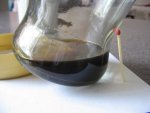OK saw these YouTube video's and thought I would post them up as a public service message for All Ecoboost owners and I am NOT saying a oil catch can will prevent this but it may help.
Not trying to go all chicken little that the sky is falling this is a known problem for DI engines for a long time but I posted it as this guy mentions certain repairs or treatments (one I was considering sea foam) and say Ford is seeing turbo failures soon after such treatments as well as possible cat converter issues. Don't know the guy and it is a issue with he 2.0 ltr Focus Ecoboost.
I am happy he pushed this up to Ford and maybe they will come back with a cost effective fix.. I was surprised at how low of mailage some of the cars he talks about have had.. Most are 3.5 and 2.0 but he does mention the 1.6 so I figured I may as well give Us all a heads up..
Again this is not to scare you or say this will happen just a PSM so we are aware of it could be happening... Plan on some sort of maint. preventive (aka oil catch can, though this will only slow the process is my guess) or Intake valve stem cleaning service of some sort..
Part 1
[video=youtube_share;0irwbwpuEbQ]http://youtu.be/0irwbwpuEbQ[/video]
Part 2
[video=youtube_share;nK2eXdaydqI]http://youtu.be/nK2eXdaydqI[/video]
Not trying to go all chicken little that the sky is falling this is a known problem for DI engines for a long time but I posted it as this guy mentions certain repairs or treatments (one I was considering sea foam) and say Ford is seeing turbo failures soon after such treatments as well as possible cat converter issues. Don't know the guy and it is a issue with he 2.0 ltr Focus Ecoboost.
I am happy he pushed this up to Ford and maybe they will come back with a cost effective fix.. I was surprised at how low of mailage some of the cars he talks about have had.. Most are 3.5 and 2.0 but he does mention the 1.6 so I figured I may as well give Us all a heads up..
Again this is not to scare you or say this will happen just a PSM so we are aware of it could be happening... Plan on some sort of maint. preventive (aka oil catch can, though this will only slow the process is my guess) or Intake valve stem cleaning service of some sort..
Part 1
[video=youtube_share;0irwbwpuEbQ]http://youtu.be/0irwbwpuEbQ[/video]
Part 2
[video=youtube_share;nK2eXdaydqI]http://youtu.be/nK2eXdaydqI[/video]





